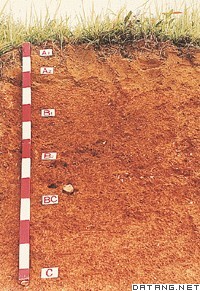1) red-soil slope land


红壤坡地
1.
Benefits of soil and water conservation in red-soil slope land by adoption of different coverage measures;
红壤坡地不同覆盖措施的水土保持效益分析
2.
Process of nutrient loss of red-soil slope land under comprehensive soil and water conservation measures;
水土保持综合措施对红壤坡地养分流失作用过程研究
3.
Based on the observed data of different types of terraces on red-soil slope land in Soil Conservation Ecological Science & Technology Demonstration Park of Jiangxi Province,an analysis was made on the effect of water and soil conservation and orange growth in different types of terraces.
应用江西省水土保持生态科技园红壤坡地不同类型梯田小区的观测资料,对不同类型梯田的水土保持效应和柑橘生长情况进行分析。
2) Sloping land of red soil


红壤坡地
1.
Results showed that it was an effective approach to raise the level of vegetation coverage with necessary engineering measures supplemented for soil and water conservation in sloping land of red soil.
通过在典型的红壤坡地建立标准径流小区进行试验,采用统计学方法对不同水土保持措施下地表径流量和土壤侵蚀量的变化情况进行了定量分析。
3) Slope land of red soil


红壤坡地
1.
The district of standard runoff was build in the south slope land of red soil for the experiment.
本研究通过在南方红壤坡地建立标准径流小区进行试验,采用统计学方法对不同水土保持措施下径流量和泥沙量的变化情况进行了定量分析。
4) red soil sloping land


红壤坡地
1.
With 4 common soil and water conservation measures : clear plough land,contour cultivation,naked level terrace and the level terrace of Bahia-grass rise on red soil sloping land as the study objects,the effects of different soil-and-water conservation measures on water conversation are analyzed,taking naked land as the control.
以红壤坡地常见的4种不同水土保持措施:净耕果园、坡地果园内横坡耕作、梯田净耕果园和梯田果园内种植百喜草为研究对象,全园裸露区为对照,对不同水土保持措施蓄水能力进行分析。
5) Red Soil Sloping Fields


红壤坡地
1.
The Cultivated Model of Red Soil Sloping Fields and a Preliminary Report on the Monitoring of Soil Erosion;
红壤坡地耕作模式与水土流失监测初报
2.
A Preliminary Report on the Study of Soil Conservation Technology of the New Exploited Orchard of Red Soil Sloping Fields;
红壤坡地新开果园水土保持技术研究初报
6) slope red soil


坡地红壤
1.
Effects of straw mulching to slope red soil on fertility maintaining and crop yield;


稻草覆盖对坡地红壤培肥及作物增产的效果
补充资料:红壤
| 红壤 red earth 发育于热带和亚热带雨林、季雨林或常绿阔叶林植被下的土壤。主要特征是缺乏碱金属和碱土金属而富含铁、铝氧化物,呈酸性红色。主要分布于非洲、亚洲、大洋洲及南北美洲的低纬度地区。大致以南北纬30°为限。在中国,北起长江沿岸,南抵南海诸岛,东自台湾省,西至云贵高原及横断山脉为主要分布区域。红壤的形成是在高温多雨、植被茂密的生物、气候条件下,土壤中富铝化和生物富集相互作用的结果。根据成土条件的变化和富铝化作用的强度,中国境内红壤可分为砖红壤、砖红壤性红壤、红壤、黄壤4个亚类。前2类多见于热带和南亚热带,土体中碱金属及碱土金属含量均低,pH4.5~5.0,适宜种植热带和亚热带作物及水稻。第3类多见于亚热带低山丘陵地带,土壤pH5.0左右,富铝化程度较前2类弱,适宜种植亚热带经济作物和水稻、玉米等。为更好地利用红壤,须对其淋溶作用强、矿质养分少、酸性大、易产生铝锰毒害、保肥性能差和质地粘重或砂粒过多等不良性状进行改良。具体措施是:增施氮、磷、钾等矿质肥料,氮肥宜用粒状或球状深施,磷肥宜与有机肥混合制成颗粒肥施用;施用石灰降低土壤酸性;合理耕作;选种适当的作物、林木,种植绿肥是改良红壤的关键措施;旱地改水田,减少水土流失并有利于有机质积累,提高土壤生产力;保护植被,防治侵蚀,凡坡度大于25°的陡坡应以种树种草为主,小于25°的坡地根据陡缓状况修建宽窄不等的等高梯地或梯田种植。
|
说明:补充资料仅用于学习参考,请勿用于其它任何用途。
参考词条
